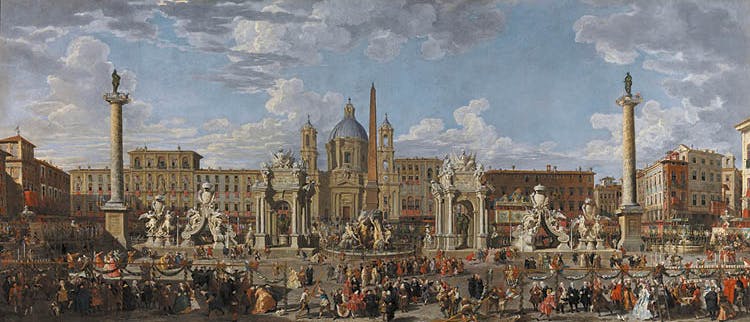
Eyewitness Views
Tags for: Eyewitness Views
- Magazine Article
- Exhibitions
Take a Grand Tour of 18th-century Europe through an artist’s eye
Marjorie E. Wieseman, Paul J. and Edith Ingalls Vignos Jr. Curator of European Paintings and Sculpture, 1500–1800
February 16, 2018
Appears in Cleveland Art, March/April 2018

The Preparations to Celebrate the Birth of the Dauphin of France in the Piazza Navona, 1731. Giovanni Paolo Panini (Italian, c. 1692–1765). Oil on canvas; 109 x 246 cm. National Gallery of Ireland, NGI.95, Purchased 1871. Photo © National Gallery of Ireland
Throughout the 18th century, one of the most popular genres of painting was the veduta, or view painting—a highly detailed, often large-scale view of a city or picturesque locale. Travelers making the Grand Tour of European capitals often purchased these paintings as pleasant reminders of their journeys. Eyewitness Views takes a fresh look at one particular group of vedute that stand out by virtue of their superb artistic quality, lively atmosphere, and historical interest: view paintings that depict landmark contemporary events. Rulers, princes, or ambassadors often commissioned these magnificent paintings to permanently document their participation in such events. Working for these prominent patrons inspired leading artists such as Canaletto, Giovanni Paolo Panini, and Francesco Guardi (see this issue’s cover) to create exceptional works of art that express the excitement and drama of occasions and encourage viewers to imagine themselves present in that time and place.
View painters used many techniques to create an atmosphere of plausible reality. Abundant fine detail was without doubt a requirement of the patron, who wanted to ensure full appreciation of his role in an event, but these details also enable modern viewers to engage with the paintings: buildings and topography are readily identifiable, and individual figures recognizable—if only by their distinctive costume. The paintings offer a wealth of information about the culture of the time, helping viewers understand the significance of these historic events. To be sure, the scenes are not always entirely accurate portrayals of a specific place or time; artists frequently shifted buildings and adjusted proportions for greater effect, but the overall impression is entirely believable.
When it came to staging grand civic celebrations, no expense was spared, for the magnificence of the event reflected on the city and the host. Elaborate ephemeral architectural decorations transformed city squares and interior spaces; ornate coaches and boats transported kings and ambassadors; sumptuous liveries clothed their retinues; and specially composed music and spectacular fireworks entertained the crowds. One of the most extravagant civic festivals took place in the Piazza Navona in Rome in 1729, to commemorate the birth of the Dauphin, heir to the French throne. Giovanni Paolo Panini’s depiction of this celebration is not only a magnificent work of art but also a fascinating document of the politics and patronage that underlie many reportorial views. The French ambassador to Rome, Cardinal de Polignac, funded and staged the celebrations and commissioned Panini to record the event in a painting. Rather than showing the celebration itself, Panini depicted the last-minute preparations: carpenters, painters, florists, fireworks technicians, and others busily transform one of Rome’s most beautiful public spaces into an open-air ballroom. Eminent spectators view the preparations, and in the foreground, near the center of the painting, is Polignac himself, directing the operations. Polignac is thus portrayed as taking an active role in organizing the celebrations. Strategically, he commissioned an identical version of this painting as a gift to the king, a permanent advertisement of Polignac’s munificence in glorifying his sovereign’s royal house.
Image

Many of the events depicted in the paintings in Eyewitness Views took place in Venice, an enduringly picturesque city that in the 18th century prided itself on its ability to put on a spectacle like no other. Perhaps one of the most impressive was the annual civic festival held on Ascension Day to celebrate the ritual marriage of Venice and the sea. Once a year, the highly decorated and gilded state barge, or bucintoro, of the doges of Venice transported the doge and the city’s senators to the mouth of the Adriatic to perform the ritual ceremony. Canaletto’s stately depiction shows the bucintoro tied up in front of the Doge’s Palace, ready to depart amid a host of gondolas and other small vessels. The doge himself is barely visible, emerging from the market stalls to the left of the palace—he’s the one wearing a gold cloak and sheltered by a parasol. A curious detail makes it possible to date Canaletto’s painting precisely: the tall campanile in Piazza San Marco had been struck by lightning in April 1745, leaving it with a jagged edge until repairs could be completed after the Ascension Day festivities.
The visits of kings, prelates, princes, or ambassadors to a city were marked by exuberant festivities; important civic and religious events merited impressive celebrations. Yet view paintings do not exclusively record civic triumphs: artists also turned their keen reportorial eye to commemorating horrific scenes of disaster and destruction. The paintings featured in Eyewitness Views offer a rich cross section of some of the most fabulous events of the 18th century.
Cleveland Art, March/April 2018
Related Content
Eyewitness Views: Making History in Eighteenth-Century Europe
Tags for: Eyewitness Views: Making History in Eighteenth-Century Europe
- Special Exhibition
Eyewitness Views: Making History in Eighteenth-Century Europe is the first exhibition to exclusively examine view paintings—more...
